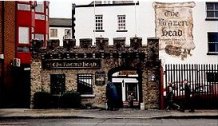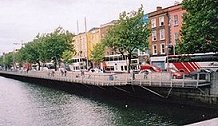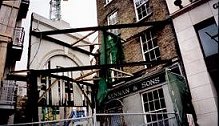The Brazen Head, the city's oldest public house, stands on Bridge Street on the south side of the river, almost opposite the Four Courts. It is claimed that its history dates back to 1198.

Not far from Bridge Street is Christ Church Place. A medieval map of Dublin shows the location of the old city walls. Christ Church Place is within that area. Here stands one of the most famous cathedrals in Ireland, Christ Church. It was erected as a wooden edifice in 1038 by the Christianised Vikings. The Normans replaced it with a stone building about 1170. Heading towards Thomas Street, a piece of the old city wall still remains.
The road which continues from Thomas Street is James's Street, home of the famous Guinness Brewery, The Brewery was established by Arthur Guinness in 1759. His father, Richard, had passed on his brewing expertise to Arthur. The original plot of land opposite St. James Gate, occupied four acres of land. This has extended to sixty acres. The Brewery provides much employment as well as its beer. Over many generations, the Guinness family have been noted for their philanthropy, particularly to the poor of Dublin.They have generously contributed to the restoration of St. Patrick's Cathedral, financed the landscaping of St. Patrick's Park, (originally a slum area), provided houses and social services for the poor in both Dublin and London and arranged to have St. Stephen's Green relandscaped prior to its opening to the public in 1877. The former hop warehouse is now used as an exhibition centre and museum.

Continue along James Street, past Saint James Church, to where the road divides into an inverted 'V'. The road on the left leads to one entrance of St. James Hospital, (the other entrance is in Rialto). The road on the right leads to Bow Lane, with St. Patrick's Hospital on the right. This hospital was founded with a bequest from Jonathan Swift. Further down the lane is the entrance to the Royal Hospital, Kilmainham, which in 1985, was awarded the Europa Nostra award in recognition of its 'distinguished contribution to the conservation of Europe's architectural heritage'. On the site upon which it is built, Strongbow established Ireland's first priory of the Knights of the Hospital of St. John of Jerusalem in 1174. The priory was suppressed by Henry Vlll in 1541. The Royal Hospital was built between 1680-84 in the style of Les Invalides, Paris, both of which were the world's first retirement hospitals for old and wounded soldiers. It became outdated and in 1913 patients were transferred to George V Hospital, (now St. Bricin's). The British Army Headquarters, Irish Command, then occupied the premises. In 1928 it closed and fell into disrepair. It was restored in
1980 at a cost of twenty million pounds. It was for this work that the award was granted. It is now an art museum.
The west entrance is diagonally across from Kilmainham Jail. The exterior of the jail displays fortress-like structure. The interior has remained unaltered. It is now a museum with many sad reminders of the past.
From Kilmainham, continue north to Island Bridge over the River Liffey. At certain times of the year, salmon are clearly visible in the water beneath the bridge. Across the road is the Phoenix Park, (Parc an Fionn Uisce in Irish, meaning 'clear water'). The name Phoenix was in some way derived from the phonetics of 'Fionn Uisce. although the meaning is not related. Lord Chesterfield opened the park to the public in 1747. It is the largest enclosed public park in the world. Its seven hundred plus hectares contains many sporting facilities, houses the Dublin Zoo, Arus an Uachtaran, (official residence of the President), Garda Headquarters, the Magazine Fort and Ordinance Survey building. Monuments include the Phoenix Monument, the Wellington Monument and the Papal Cross. Gates from the park lead to the country side, back to Kilmainham, to the North side of Dublin or to the city centre.
 Update on Dublin (2002)
Update on Dublin (2002)
Since writing the foregoing in 2000, there have been several changes in Dublin. These are ongoing.
Standing on O'Connell Bridge, facing westward, a walkway has been built on the inside of the Liffey wall at the right hand side of the river. This is an alternative to the existing footpath.
Just west of the Halfpenny Bridge a new river crossing (The Millennium Bridge) is available to pedestrians. Further along work is in progress for yet another link, not for pedestrians but for the new transport system called 'The Luas'.
Two new Light Rail systems will be built, The Luas and The Metro. These are required to overcome the congestion caused by car usage and increased population levels in various areas of Dublin county. The Luas is an on-street light rail system and should be operational in early 2003.
The preparation for this 'State of the Art Transit' for Dublin is currently resulting in chaos in many areas between traffic diversions and roads being dug up.
The form of transport selected for the Luas is Citadis trams, forty of which will be used on three lines, A, B and C. They each can carry up to 235 persons, the main disadvantage being that only 60 seats will be available. The maximum speed is quoted as 70km/h.
It is proposed that they operate at five minute intervals at peak time and at intervals of ten minutes during off peak hours and will operate twenty-four hours per day. Working to capacity, one could estimate that 40 trams X 235 persons would result in 9400 persons being catered for at a given time, say peak time, without traffic jams or delays. It sounds impressive.
The Metro, with no on-street sections, will be built later.
The sculpture nicknamed 'The Floosy in the Jacuzzi' has been moved from O'Connell Street. Hoarding hides the work taking place where it stood.
About 300 metres east of O'Connell Street, a beautifully restored 18th Century Georgian Townhouse houses The James Joyce Centre. Joyce family portraits, information on people who were immortalized in Joyce's writings, maps showing the North Dublin area prior to redevelopment, a library devoted to James Joyce's life and work, may be seen at this centre. Besides works and memorabilia of James Joyce, the decorative plasterwork, the work of Michael Stapleton in 18th Century, displays part of Dublin's architectural heritage.
Moving south-west to Fishamble Street, work on the site of the Old Music Hall, where the first performance of Handel's Messiah took place in 1742, has been completed. Fashionable apartments are now on the site. A replica of the original archway, accidentally destroyed during rebuilding work, is now in place. A bronze statue of a musician, naked except for his baton, dominates the courtyard.
On a historically interesting and ironic note, St. Werburgh's Church near Dublin Castle, contains the remains of both Lord Edward Fitzgerald and Major Charles Sinn, head of the Dublin police, who fired the shot that resulted in the death of Lord Edward on 4th June 1798.

 Read the WIZ information on Ireland
Page One
Read the WIZ information on Ireland
Page One

